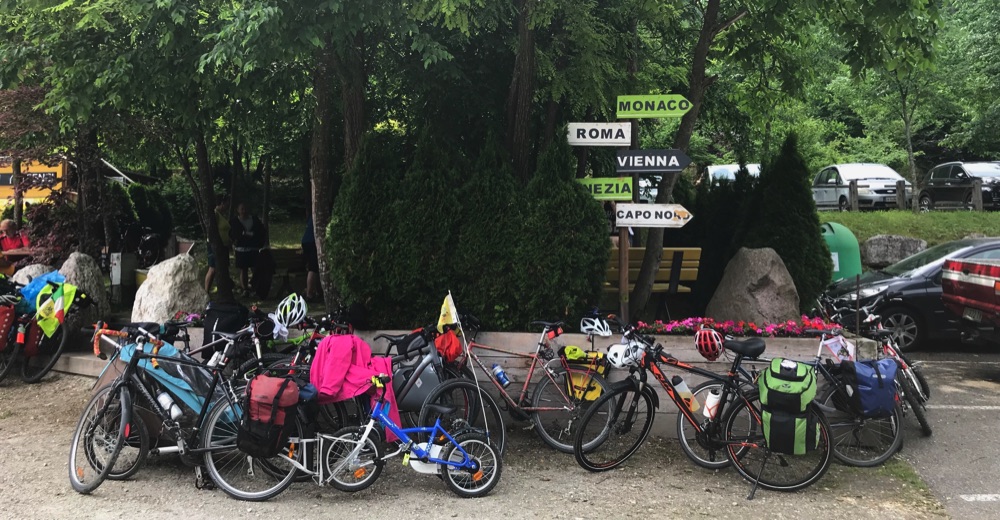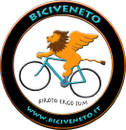WEATHER
The entire Veneto region, from the Dolomites to the plains, is subject to violent, dangerous, and sometimes terrifying thunder storms, with high winds, blinding rain, and often hail as well, all of which make it impossible to ride even a few meters. The storms not only cause dangerous fallen trees and power lines, but sometimes treacherous flash floods and landslides. Super cells and tornadoes are another possibility: the most powerful twister in the recorded history of Europe (an F5!) cut a swath of destruction from Bassano del Grappa to Nervesa della Battaglia in July 1930. A tornado that hit Venice in 1970 sank a vaporetto, killing 20 passengers. In recent years, the town of Riese Pio X and areas of Venice and other provinces, and even an unlikely place like the narrow Valbrenta have been hit. In October 2018 an apocolyptic storm named Vaia downed millions of trees, spawned floods and landslides, and caused tremendous destruction (including, alas, a number of bike paths). Always check the weather report before heading out on a ride. If you’re riding and hear or see a storm approaching, take shelter while you have the chance. I've had to do it on many occasions, even when I was near home or my destination. Once I'd just made it down to Vallonara, at the foot of the Asiago Plateau, when needle-like rain drops driven by violent wind made it almost impossible to see. I desperately rode right through the open bay doors of an auto repair shop, where the mechanics gave me clean shop towels to dry off with, and then had to close the doors. On other occasions I stood shivering at the west end of the Alpini Bridge in Bassano, which wind-driven rain made impossible to cross, or huddled with friends in a house that was under contruction, or holed up in bars. Always take a lightweight jacket or vest in your pocket or bag (saddle, top tube, or handlebar). Temperatures can drop rapidly and dramatically. I once had to call a taxi for two cyclists on a ride I was leading, which started out on a warm, sunny day that turned cold quite suddenly, a condition for which they were unprepared. On another occastion, the cyclist I was guiding bought a windbreaker in a mom-and-pop store in a little town. Ride saved and shopkeeper happy.
This video was taken from the garage of a kind family living at the northern end of the austere Mis valley. Descending the narrow valley lined with sheer rock walls towering overhad, in a storm, would have been exceedingly dangerous and foolhardy. It was cold, too! They did invite me inside but I enjoyed watching the storm.
JUST RIDING ALONG...
If you find yourself riding in a group of local cyclists, or on an organized ride such as a granfondo, you'll note that Italians do not ride along shouting warnings of holes and objects in the road (have you ever heard the pros do that?). Instead, they will quietly point out glass, holes, rocks, and so on. It is assumed that everyone in the group is alert and paying attention to other riders’ movements and hand signals, and to what's going on around them. This is especially important if the riders ahead suddenly encounter, say, a pothole that gives them no time to point it out (in which case they would not want to take a hand off the handlebar either). This is part of roadcraft. Nor do Italians constantly yell out car up! car back!, as Americans compulsively do (I once lead one person on a ride, and in spite of the fact that he was was behind me, he nevertheless kept shouting "Car up!" Go figure!) If the group is spread out on a narrow road, you are in the back, and the riders ahead don't seem to be aware of a car approaching from behind, it’s ok to shout macchina (MAH kee nah). But please don't shout, "Slowing!" Stopping! "Turning!," as I heard some American cyclists do; this embarassing, annoying, practice made them sound like a bunch of noisy children just learning to ride.
Blindly following the leader is to be avoided! At stop signs and intersections, always stop and look for yourself. I recently witnessed a long column of foreign cyclotourists riding like a flock of sheep, right through a stop sign at a blind intersection. They were not paying attention and not even one stopped to look. Fortunately for them, the road coming from their right has little traffic. On another occasion, a client on my ride rode ahead and right through a stop sign, this one, too, at a dangerous intersection. "You just blew a stop sign, you know," I told her, to which she replied, "Does a stop sign mean you really have to stop?"
Don't try to show off by picking up the pace or attempting to drop your companions; it’s not only impolite, but such actions may backfire and you'll pay dearly for your foolhardiness. (Of course, you are free to ride at your own pace on a climb, and to respond to challenges). Ride smoothly and predictably and do your share of the work, and you will earn respect. (No half-wheeling or overlapping wheels either). When you stop, offer everyone a coffee, glass of wine (un'ombra), or a beer. They'll probably refuse and treat you instead, but you will have shown good form (then again, it's customary that he who offers first, pays),
Don’t try to keep up with locals on unfamiliar descents, unless you are a skilled, experienced descender and adept at following wheels on winding roads, at speed. I know of many visiting cyclists who have come to grief that way. (Testosterone and pride usually play a large part).
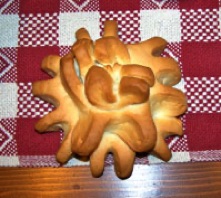
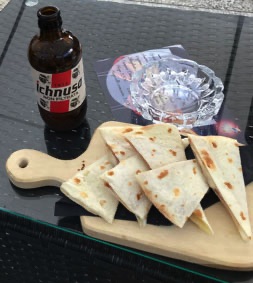

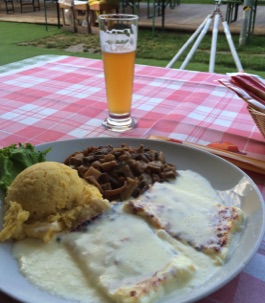
a toast
a piadina
a tasty bruschetta at El Mighelon
in Nave di Mel (no longer open, alas).
this too is a panino!
More Dolomites specialties: polenta, mushrooms, and cooked cheese at the Pedavena resturant, where (unlike other restaurants) you can eat at any hour.
Dolomites favorites: gnocchi al ragù, polenta, and grilled cheese, with cabbage and boiled potatoes, at the Festa della Patata in Cesiomaggiore, "the town of cycling." Beer and wine are always served at local festivals, which are a great dining option. You'll get to sample local specialties and mingle with the town's inhabitants.
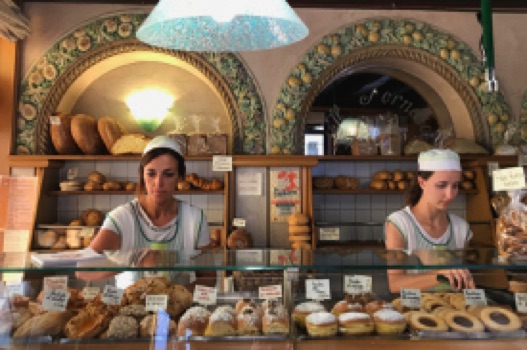
Cookies and pastries are sold in a pasticceria, many of which also serve coffee and other beverages. Biscotto (beess KOTE toh, NOT bisscoddi) is the generic word for cookie. (The word biscotti, like panini, is plural). The crunchy, oblong treats that Americans call biscotti are known as cantucci/cantuccini. Pastries are pasticcini or dolci.
Ask for un caffè, not un espresso (or worse, expresso! ). All coffee is espresso, though some establishments do serve caffe americano. If you ask for latte you'll receive a glass of milk. Caffelatte will get you the milk+coffee drink you desire. (It's usually served for breakfast, but folks sometimes have it for a quick, light supper, served in a very large cup or bowl, with crunchy bread or breakfast biscotti dunked in it (just as Americans might make a dinner of breakfast cereal). Coffee is to be savored for its own taste, so don't expect to find hazelnut, caramel, pumpkin spice, mint, or other flavors, or variations like a flat white. Nor does coffee come in different sized cups. Half of an already teeny cup is standard, and finding that unsatisfying, I usually order a macchiatone, that is, a "large" caffè macchiato --coffee with a dash of milk, either hot (caldo) or cold (freddo)-- which is served in a (relatively) larger cup.
Ignore the self-styled sophisticates and smug know-it-alls who tell you that Italians never, ever, drink a cappuccino after noon time, and that doing so labels you a clueless tourist. While that may be true among certain types of people or in certain parts of the country, I've seen my native-born Veneto friends order cappuccini in the afternoon, evening, and even very late at night. Drinking a cappuccino in non-breakfast hours may not be customary, but it's not an embarassing faux pas and the barista and other patrons will not laugh at you. They couldn't care less. Not drinking a cappuccino in the afternoon or evening will hardly fool anyone into believing you're a local anyway. (And for that matter, what's the matter with being a tourist (or better, a visitor)? It's not something to be ashamed of--on the contrary, people will be curious and want to know who you are and where you come from, and will be pleased that you are visiting their area, which will lead to pleasant, memorable cultural exchanges. That said, drinking coffee of any kind along with lunch or dinner (an American practice) is something that you really should not do! It's not a matter of custom or protocal; it simply indicates of a total lack of understanding and appreciation of food. Choose mineral water, wine, or beer instead
The usual procedure is to check out the offerings, choose what you want, then make yourself comfortable and wait to be served. Generally, you pay when you have finished.
• It’s not a good idea to leave bikes unattended and unlocked. Bike thieves, mostly from eastern Europe, may be watching, or happening to pass by on a bike hunting expedition. Just because you have parked your bike in sight doesn’t mean that someone can’t quickly jump on it and ride off, or sweep it up and toss it into a waiting van. It happens. I carry an Ottolock for snack stops.
FOOD & DRINK
BARS ARE YOUR FRIEND
Who needs convenience stores? Café bars (simply called bar) are found everywhere, and they not only serve alcoholic beverages, but much, much more: coffee, mineral water, soda, iced tea, fruit juices, brioches, sandwiches, and other "fast food" are staples. In virtually every bar you can order a toast (toasted prosciutto and cheese sandwich) or panino (panini is plural, so if you ask for panini the server will ask you quanti?--how many). Keep in mind also that panino, a diminutive form of pane, bread, simply means a bread roll, which can be purchased in a paneficio, i.e. a bread bakery, or grocery store (alimentari). A panino ordered in a bar is typically a hard roll with either soppressa (salame), prosciutto, or porchetta, and/or cheese. A hot sandwich is a panino caldo, and may be warmed in a toaster oven, not necessarily a press.
There are yet other delicious, satisfying snacks that you may find in bars and paninoteche (sandwich shops): a tramezzino is a sandwich made with thin (American-style) bread cut into triangular sections with the crusts removed, and with various soft fillings. A piadina is a toasted flatbread sandwich with cheese (often brie) and prosciutto, or other ingredients such as mushrooms and rucola (arugula). (They are a specialty of the Romagna region; Marco Pantani's mother owned a piadina stand). Finally, there's the bruschetta (broos KET tah, NOT broosheddah!). They are made with large, thick slices of bread, topped with the same ingredients used on pizze, and toasted (they're a boon for eateries, as they don't have to hire a pizza chef or install a pizza oven).
Cultural note: When entering a bar, it's a nice practice to greet not only the barista, but to glance around and give a friendly smile, nod, and buon giorno to other patrons. The same thing goes when leaving, adding a grazie to the barista/server. (Do not say ciao, which is informal and not used to greet strangers, though it's ok to say to any cyclists you may encounter).
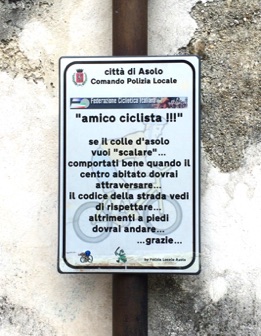
The Veneto may seem like a cyclng playground, but it is governed, nevertheless, by laws and protocols which must be respected. To start, since bicycles are regarded as valid vehicles, riders are expected to obey the laws just like all other road users. (Studying euro road signs is essential). You may see Italian cyclists riding more than two abreast, hogging the road, running red lights, and exhibiting other bad behavior. DON'T DO IT!
• You can be ticketed for failure to stop at a red light or stop sign, for not yielding to a pedestrian on a crosswalk, for talking on a cell phone, for wearing earbuds, and for riding in a pedestrian zone, among other infractions.
• Cyclists are permitted to ride against traffic on one-way streets where the speed limit is less than 30 kilomters per hour.
• Pedestrian crossings are for walkers only, so dismount if you want to use one. Striped crossings with a blue background are for cyclists.
• It's the law that cyclists must utilize a bike lane or path if one exists (often ignored, especially when the path is impracticable, blocked by parked cars, etc.), and that at dusk they must have head and tail lights and wear a reflective vest.
• Peeing or changing clothes in plain sight are no-nos and can incur a fine, as well as incite animosity towards cyclists on the part of those viewing such acts, especially locals.
The barista may offer a dash of cocoa (cacao). There's no such thing as free refills, but if you are breakfasting at a B&B, agritour, or hotel, and ask for caffelatte you will be given small carafes of coffee and hot milk, which you can mix to your liking, Some hotels serve a buffet breakfast, and on this occasion you can help yourself to as much coffee as you wish!
For decaffeinated coffee, order a caffè deca (cappuccino deca, macchiato deca, etc.). When it's hot outside, a caffè shakerato (coffee shaken with ice) is the way to go.
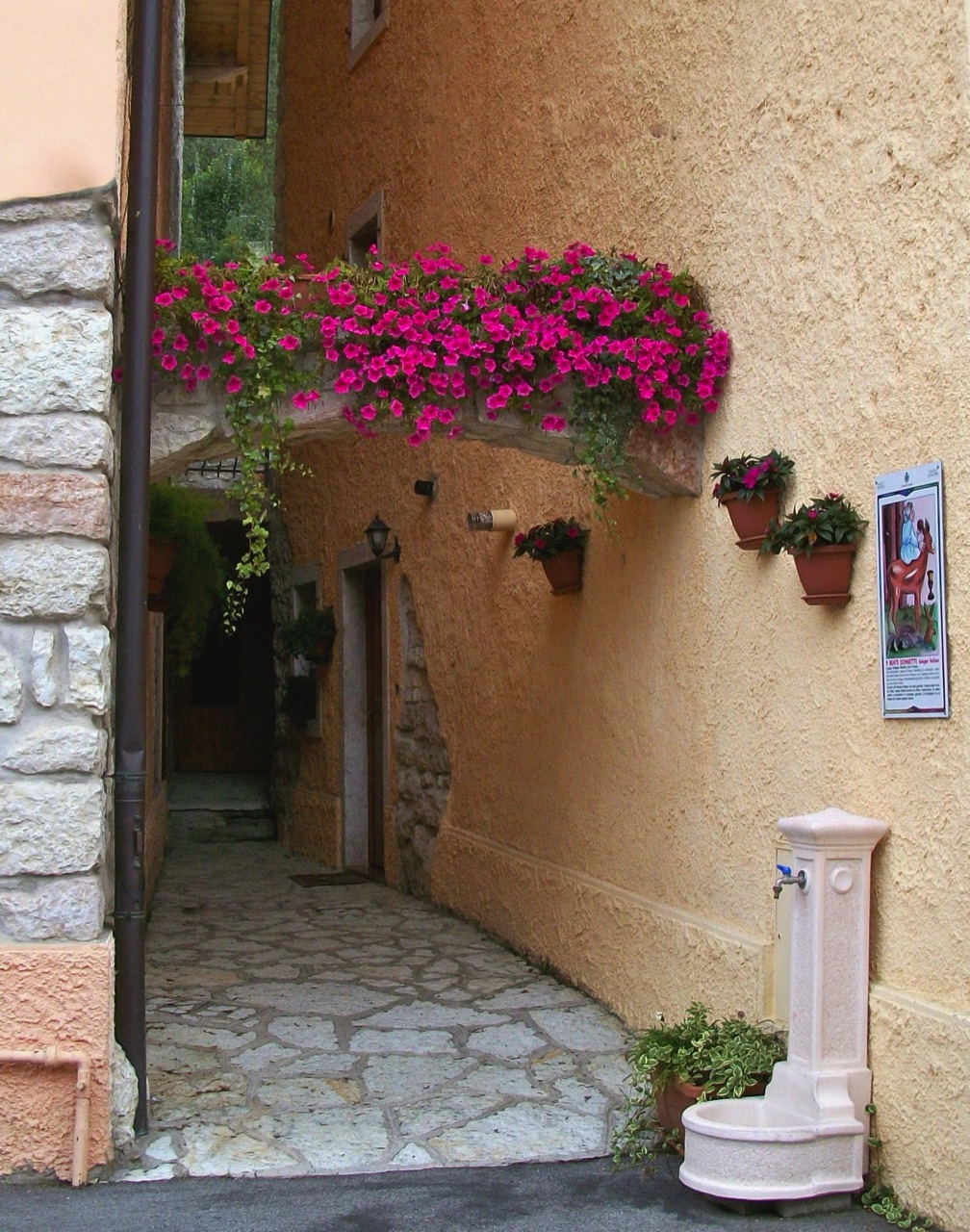
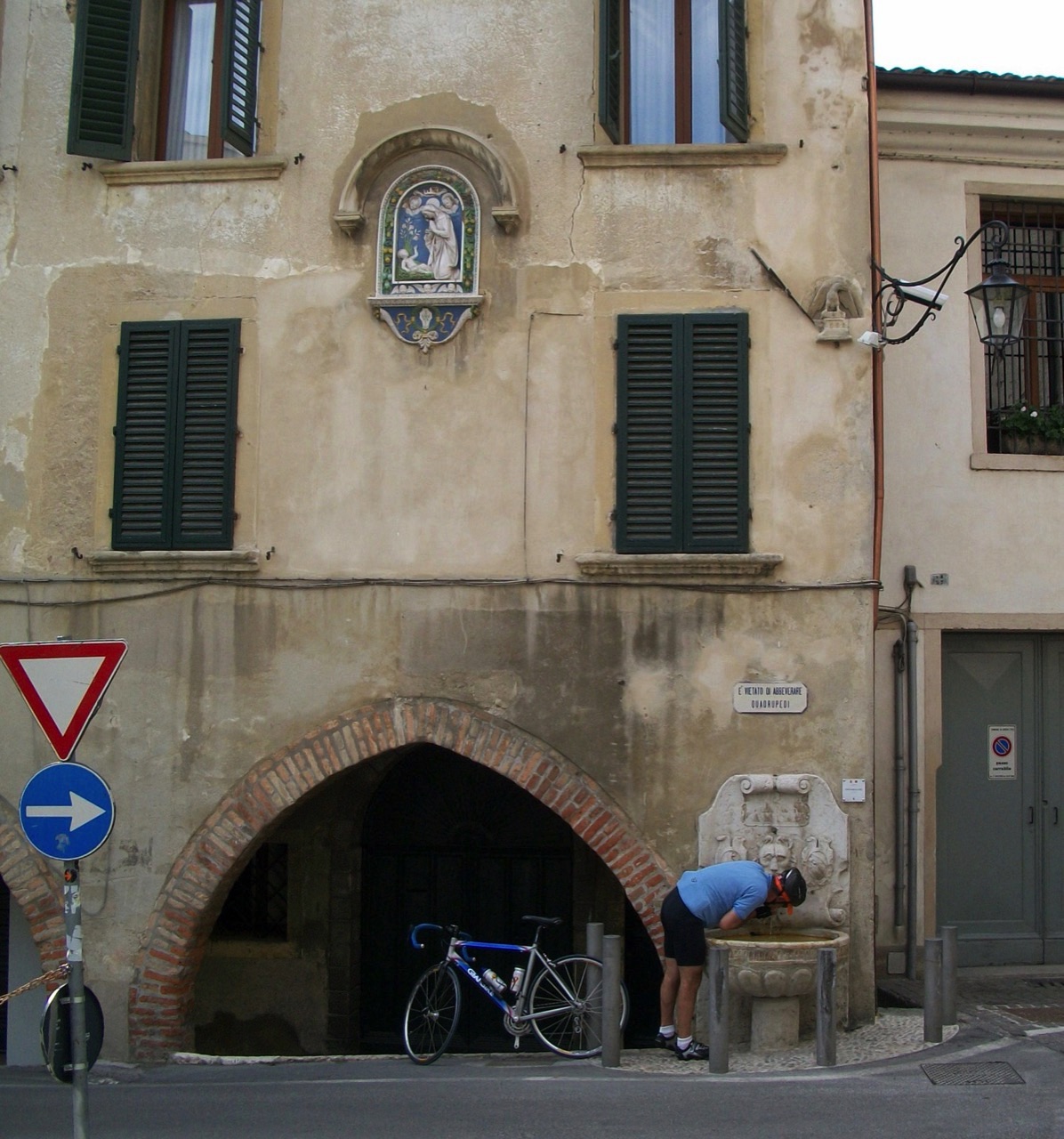
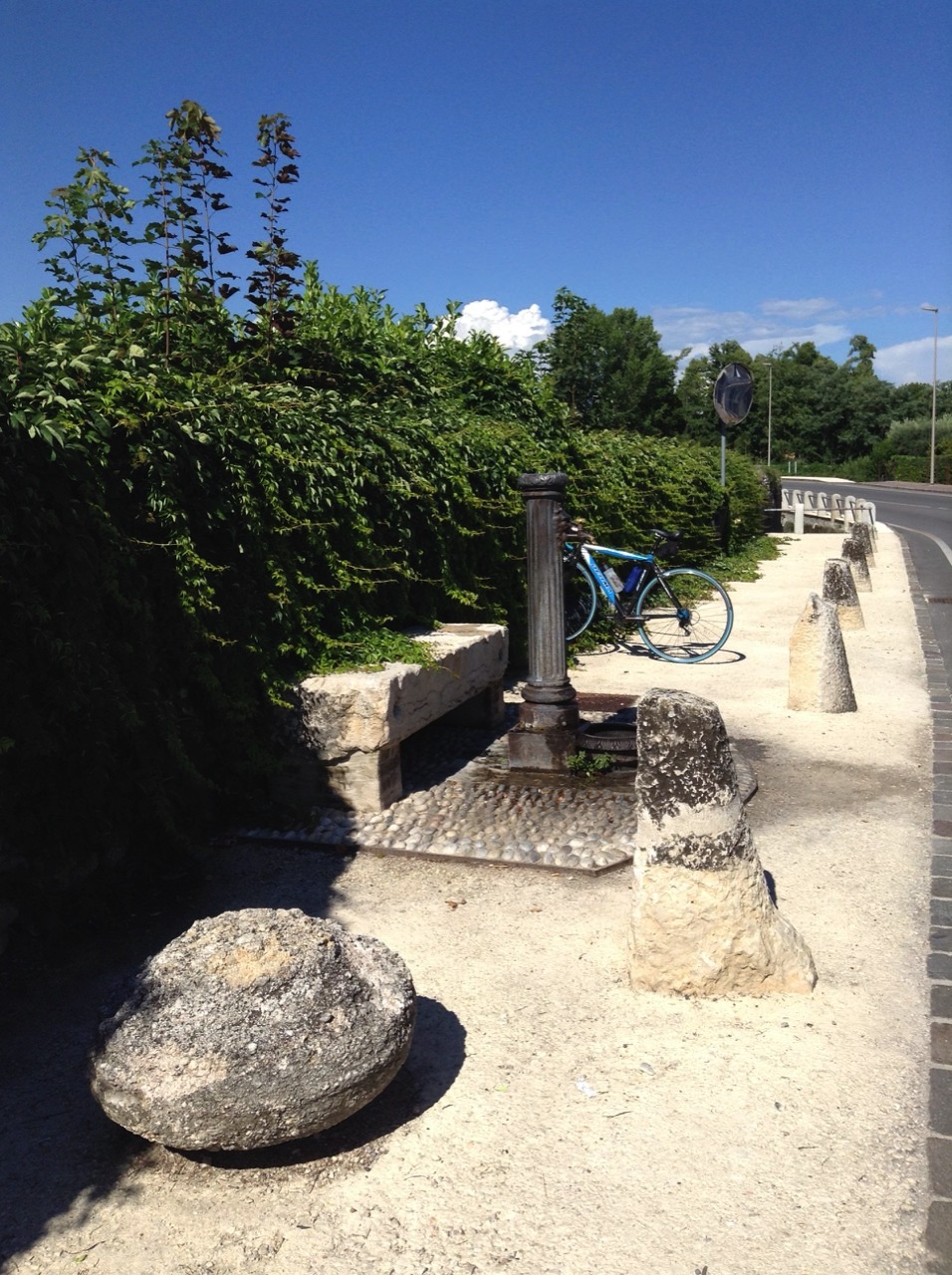
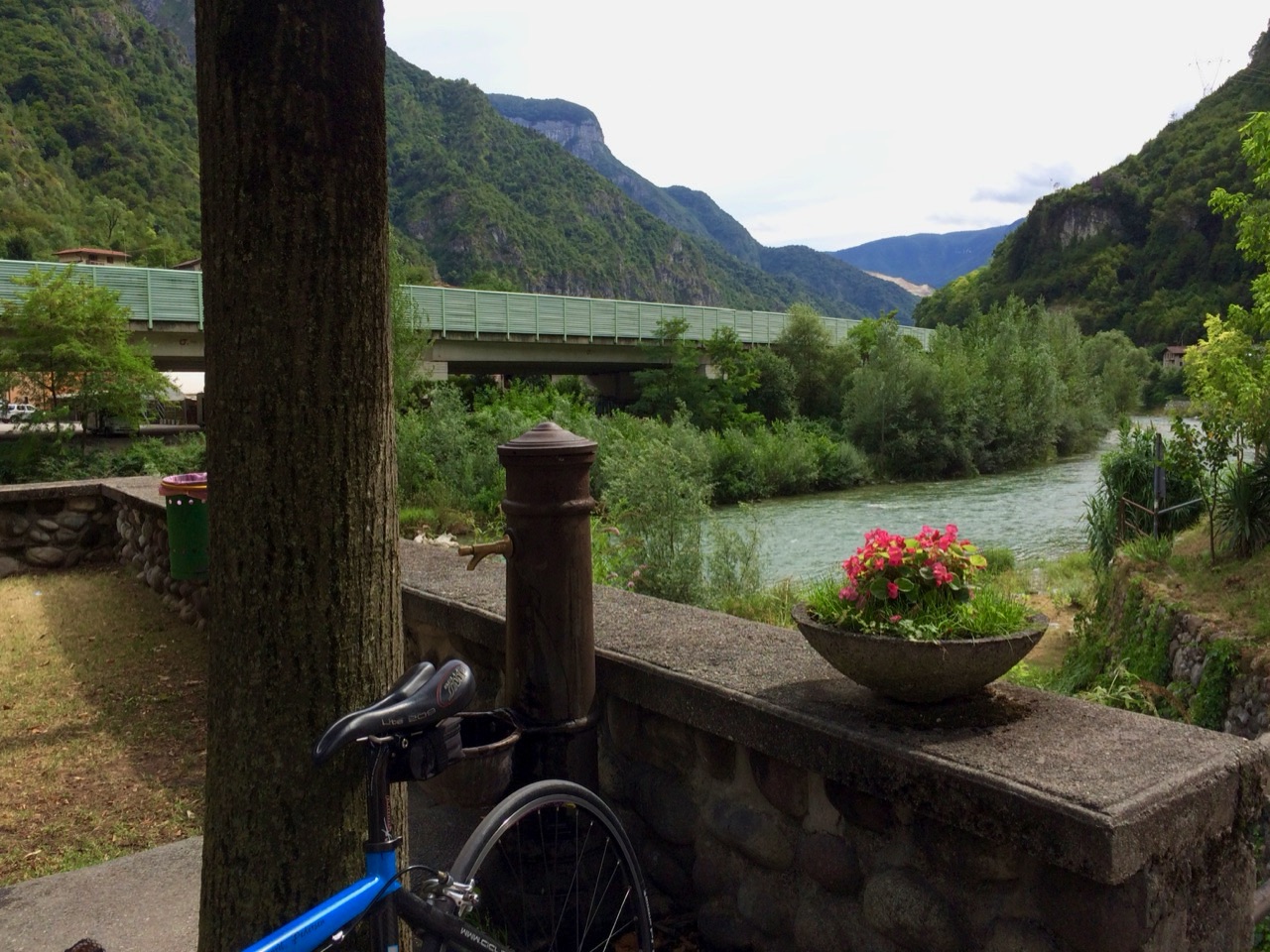
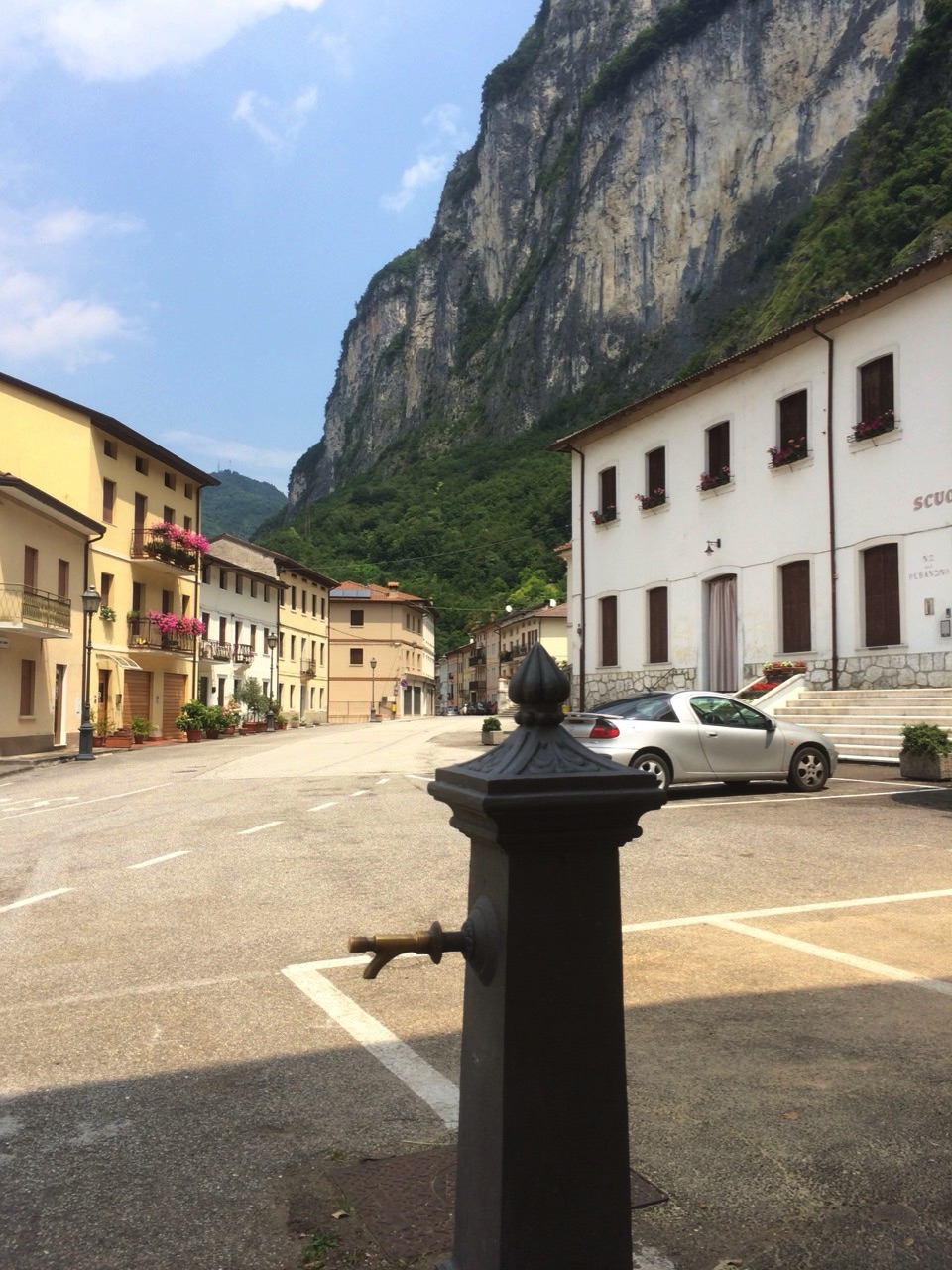
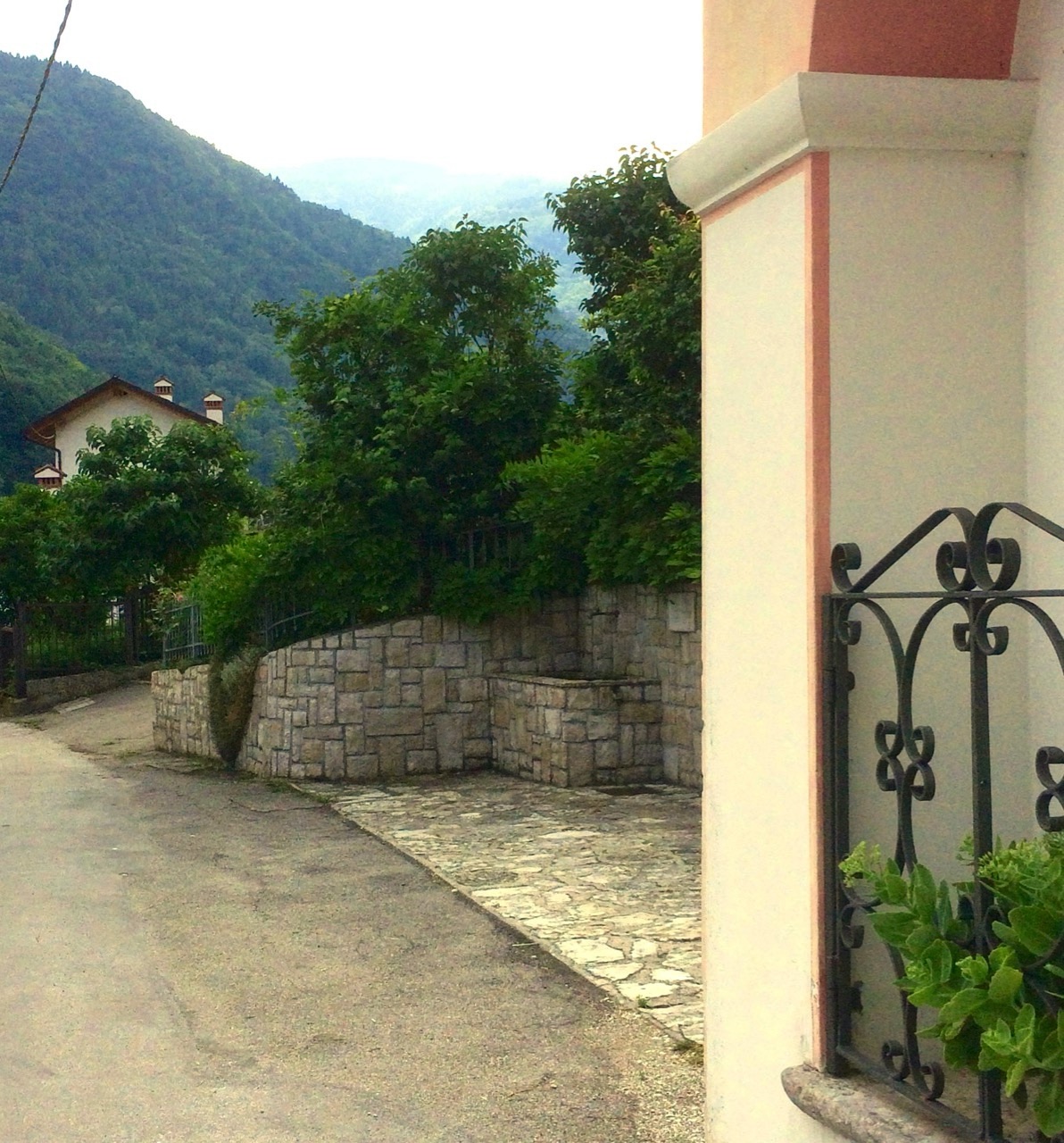
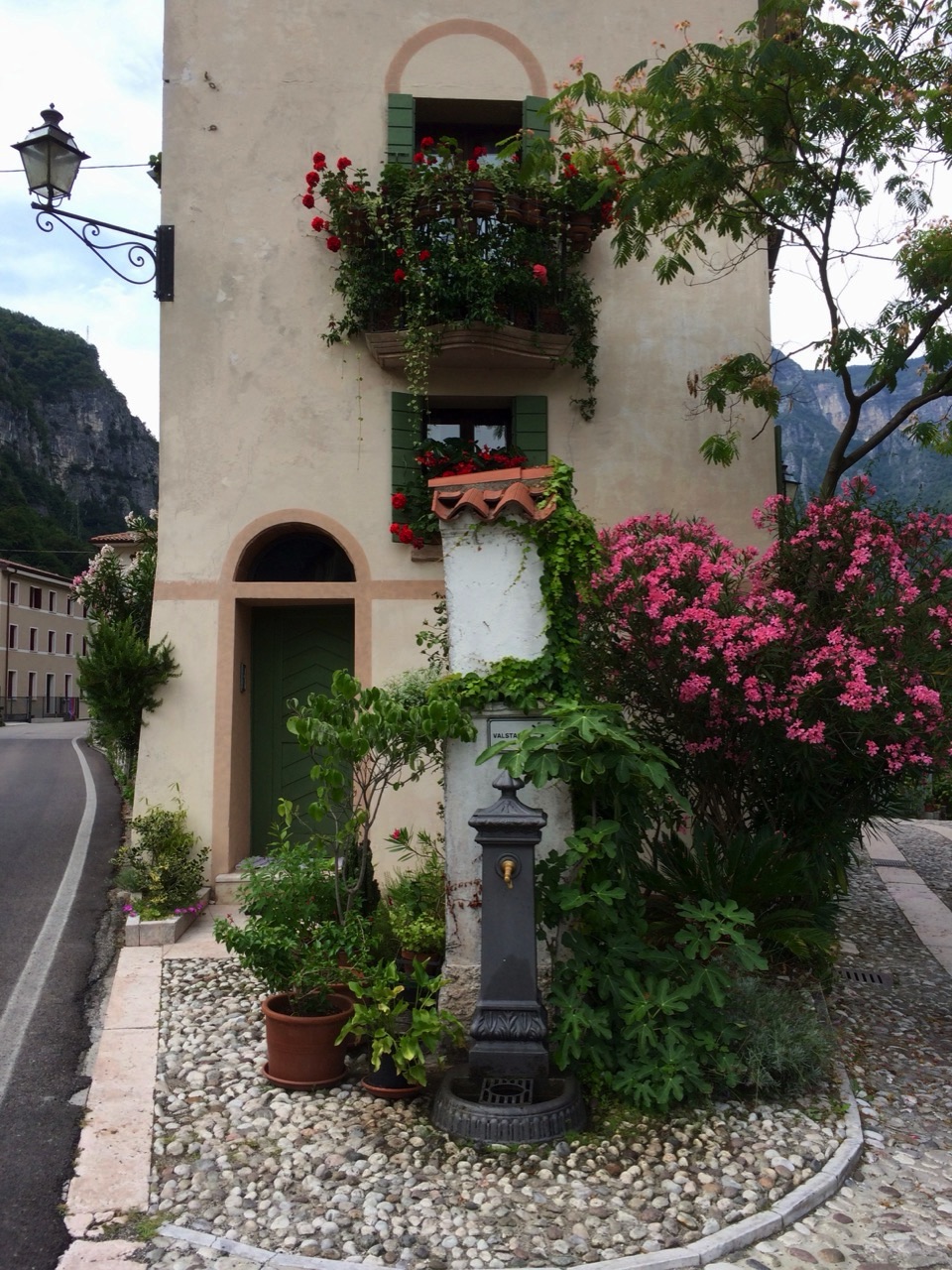
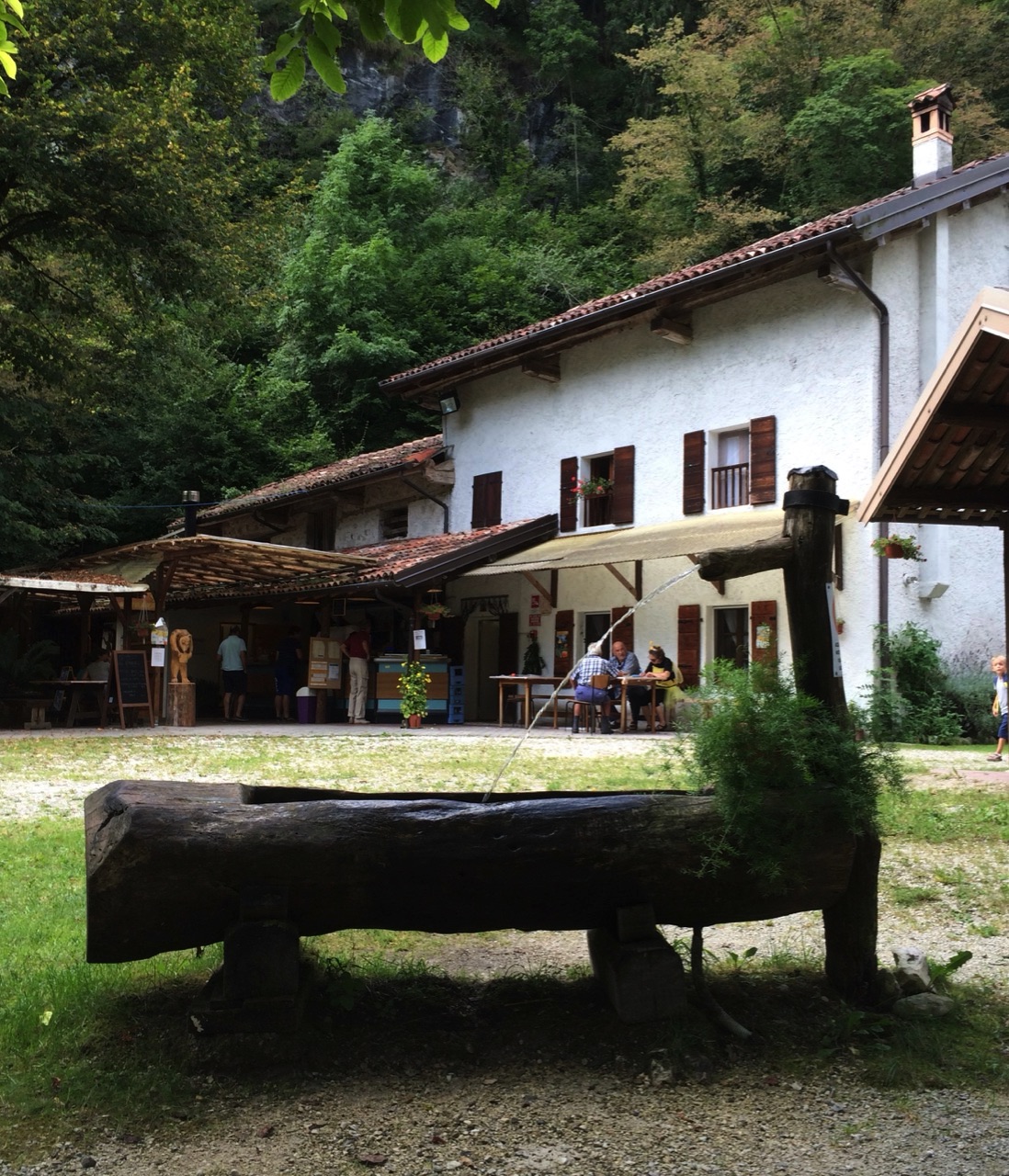
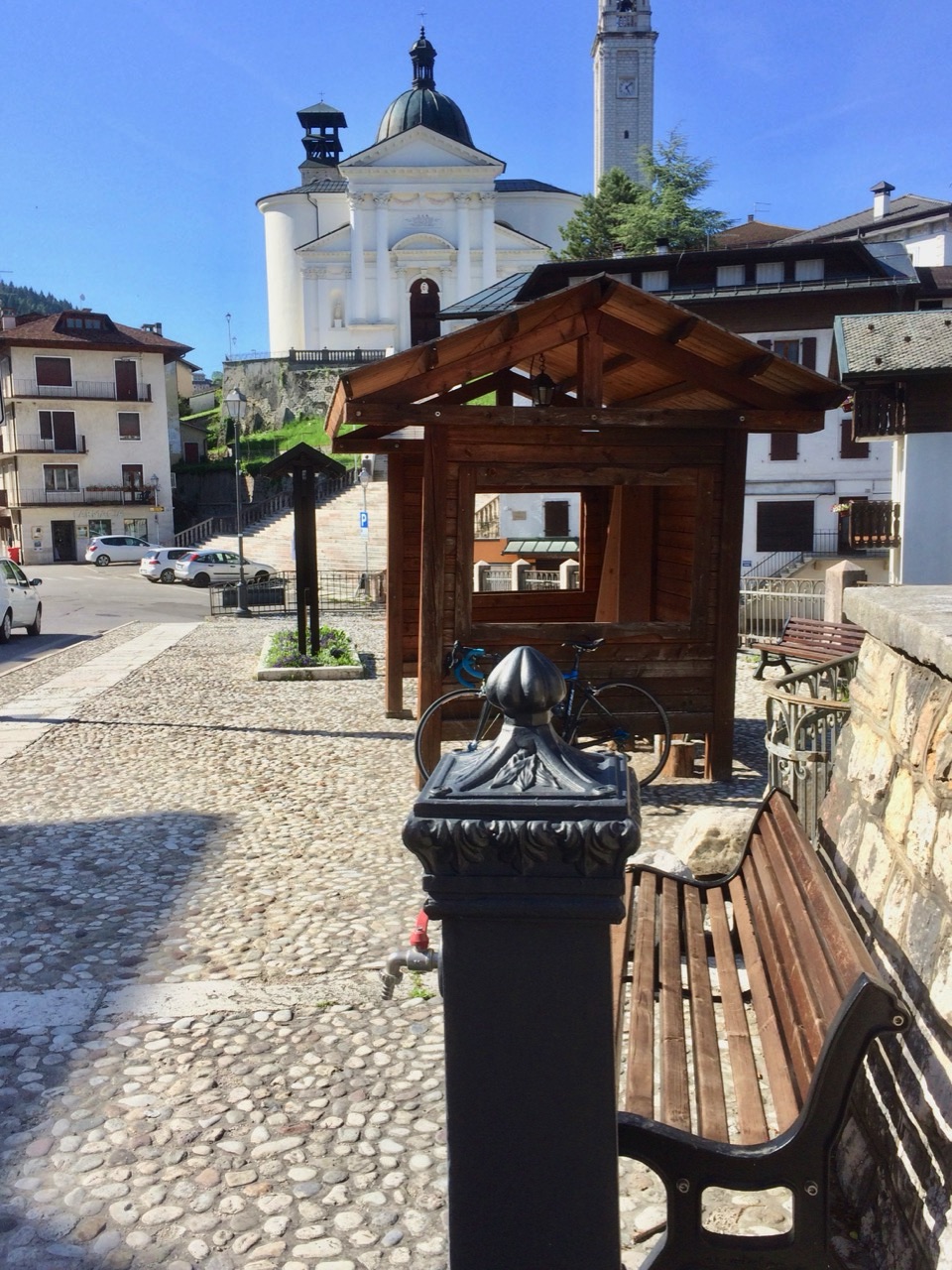
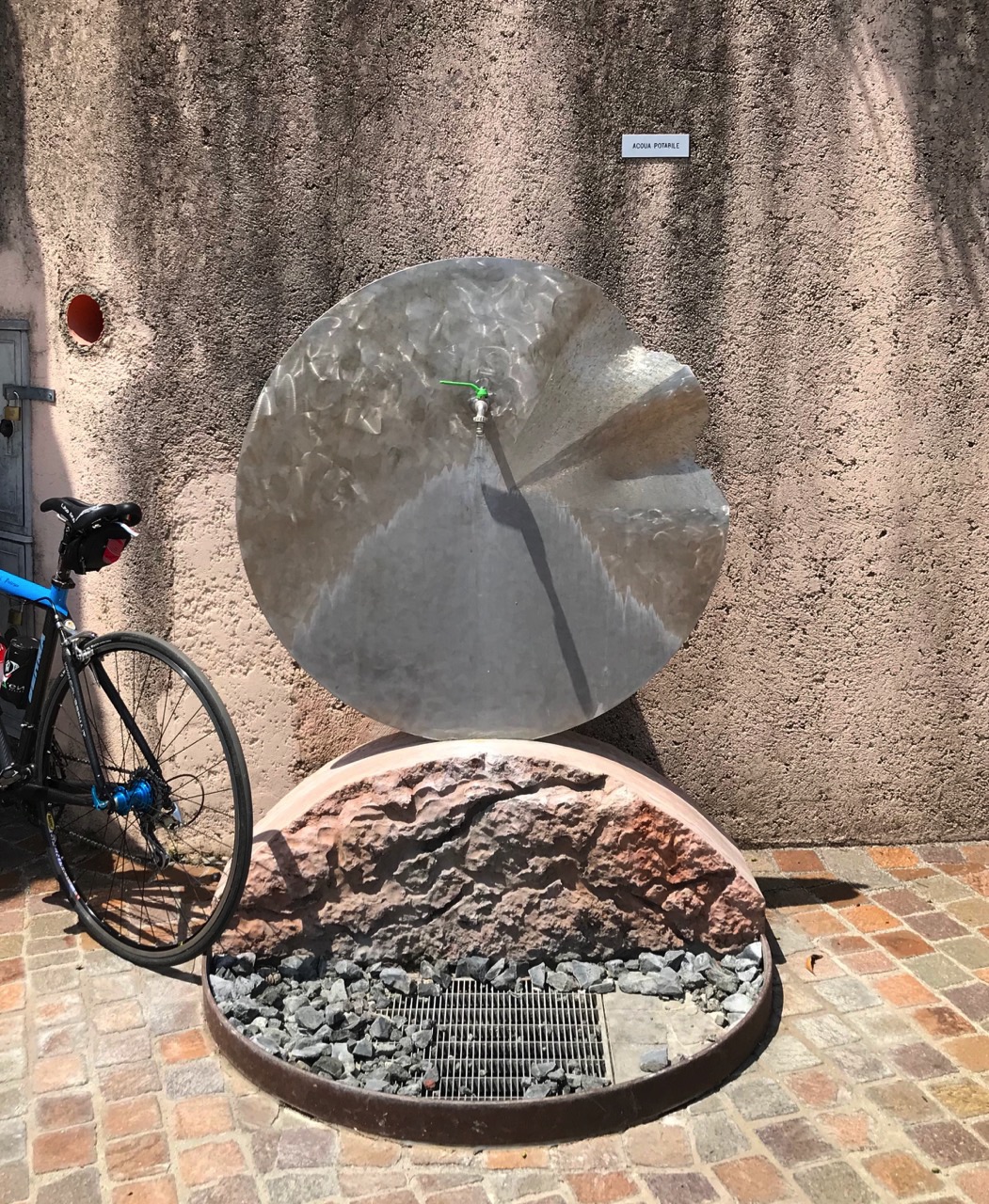
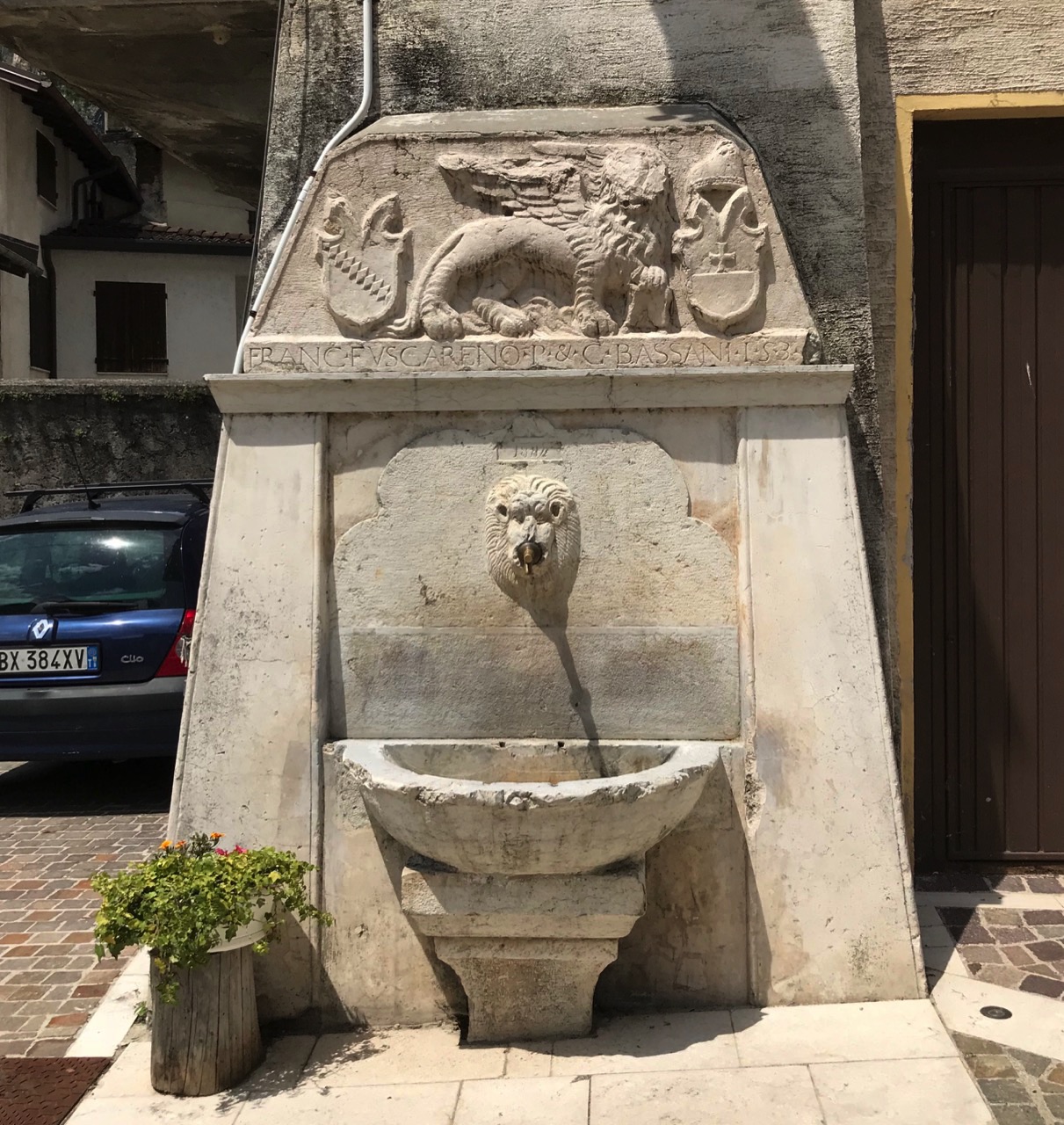
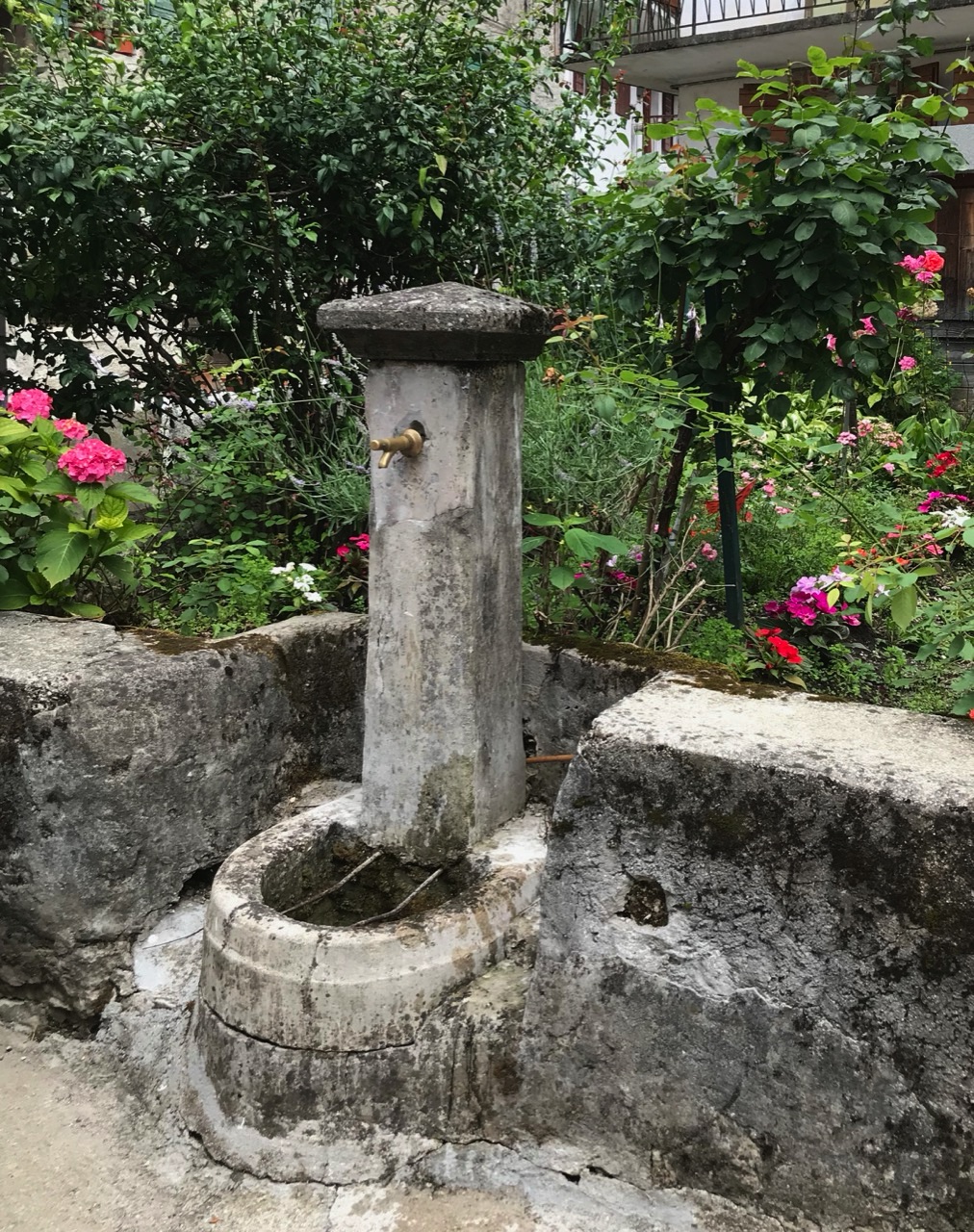
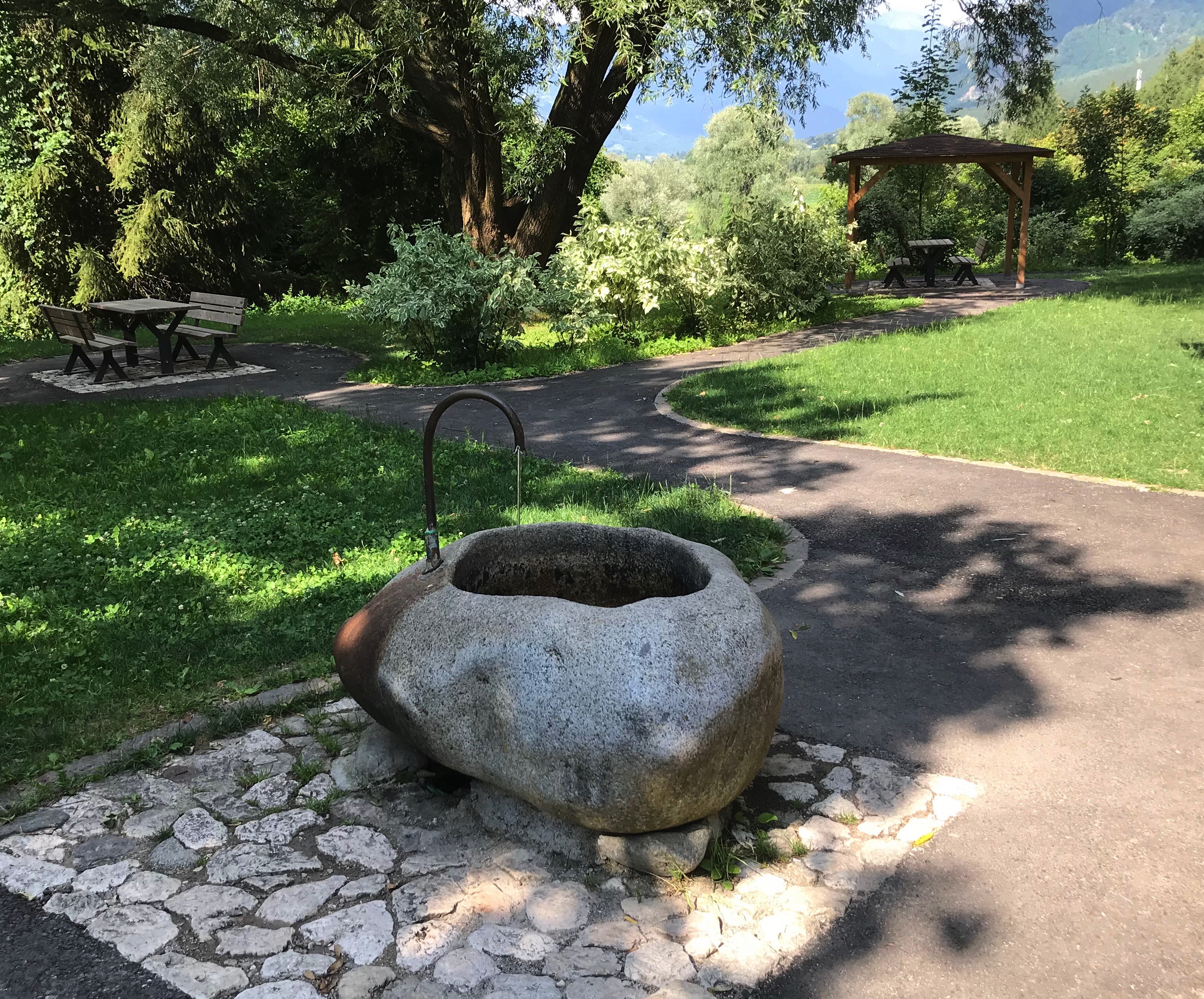
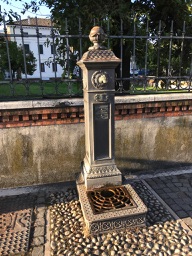
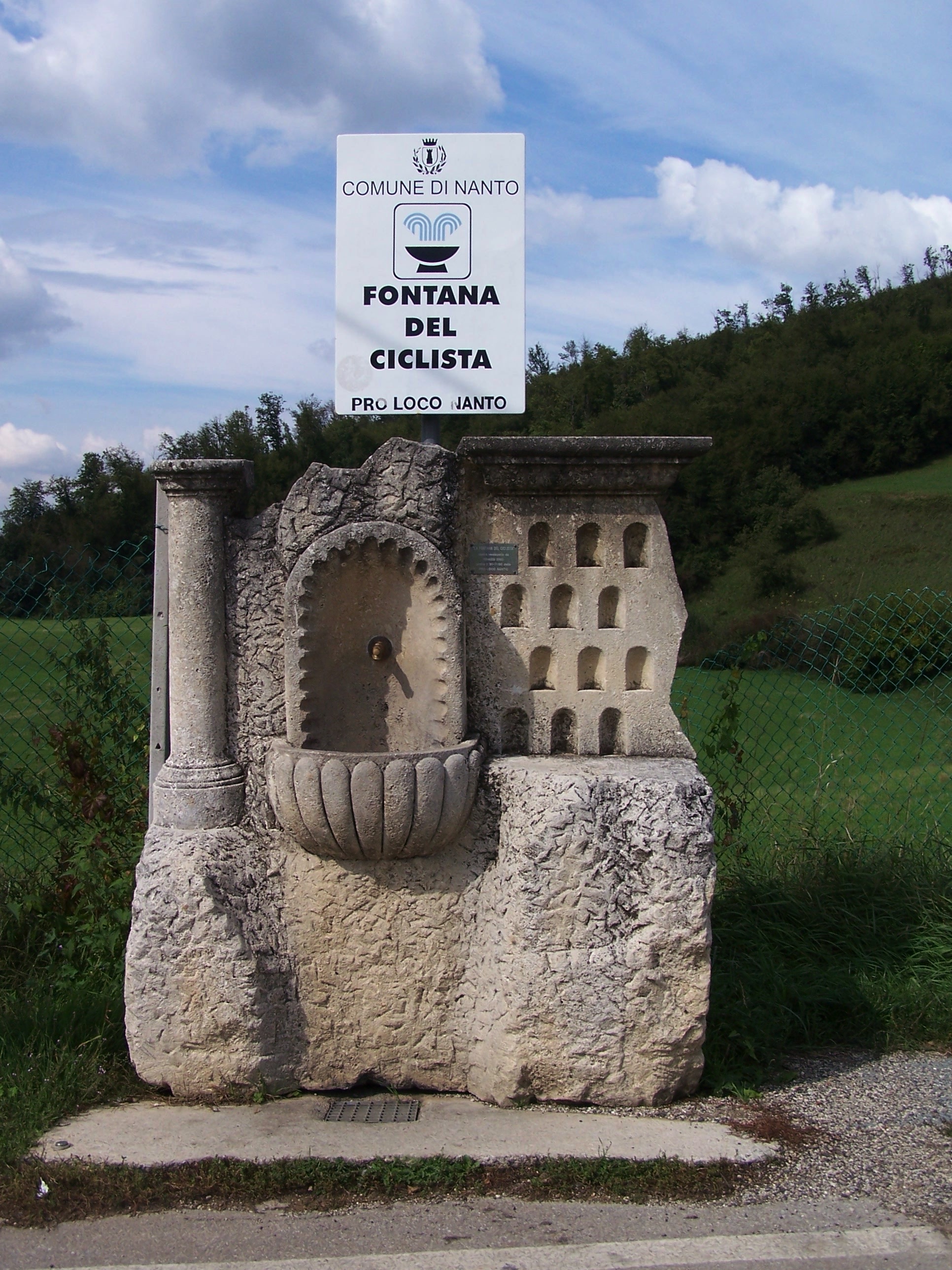
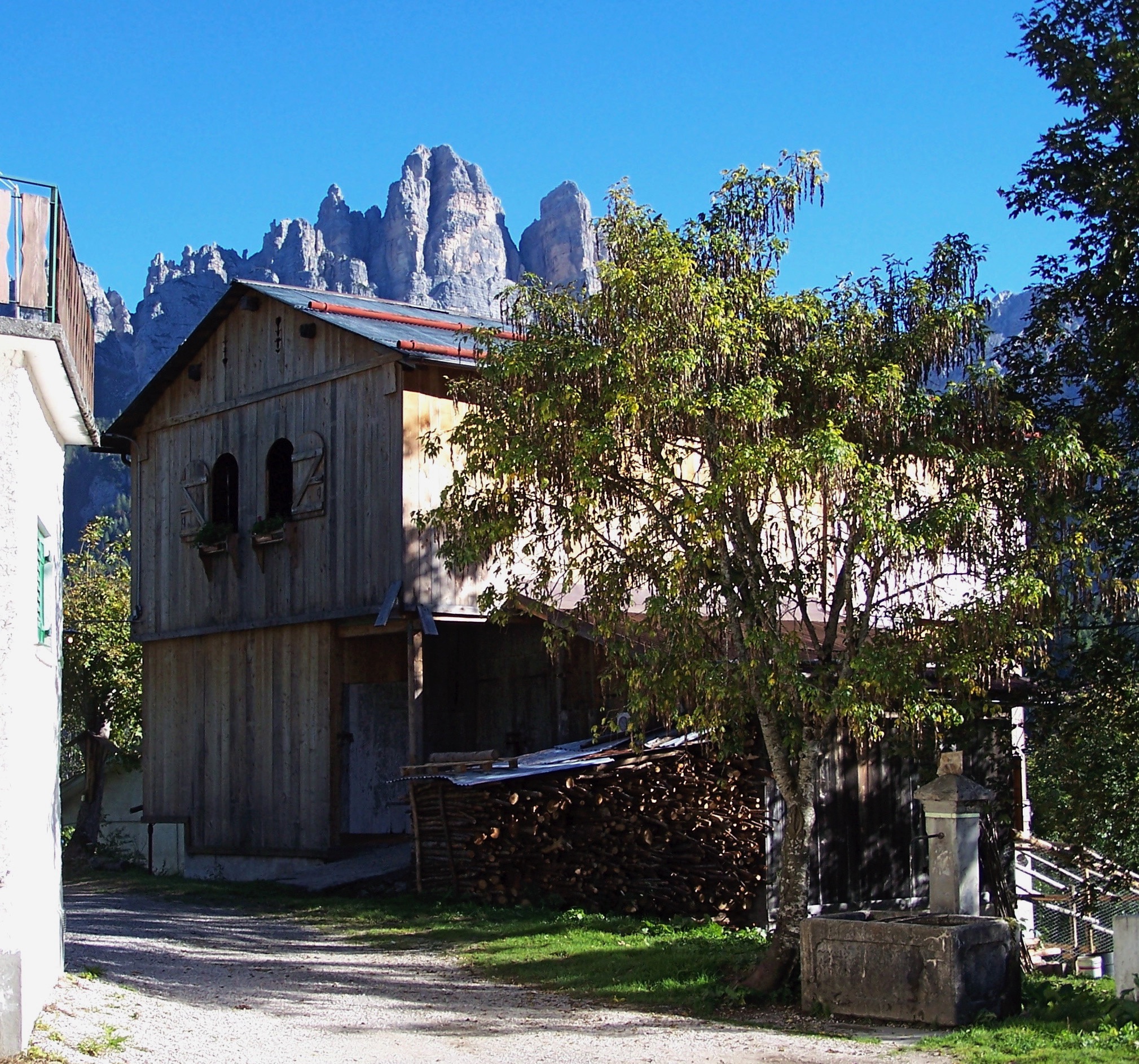
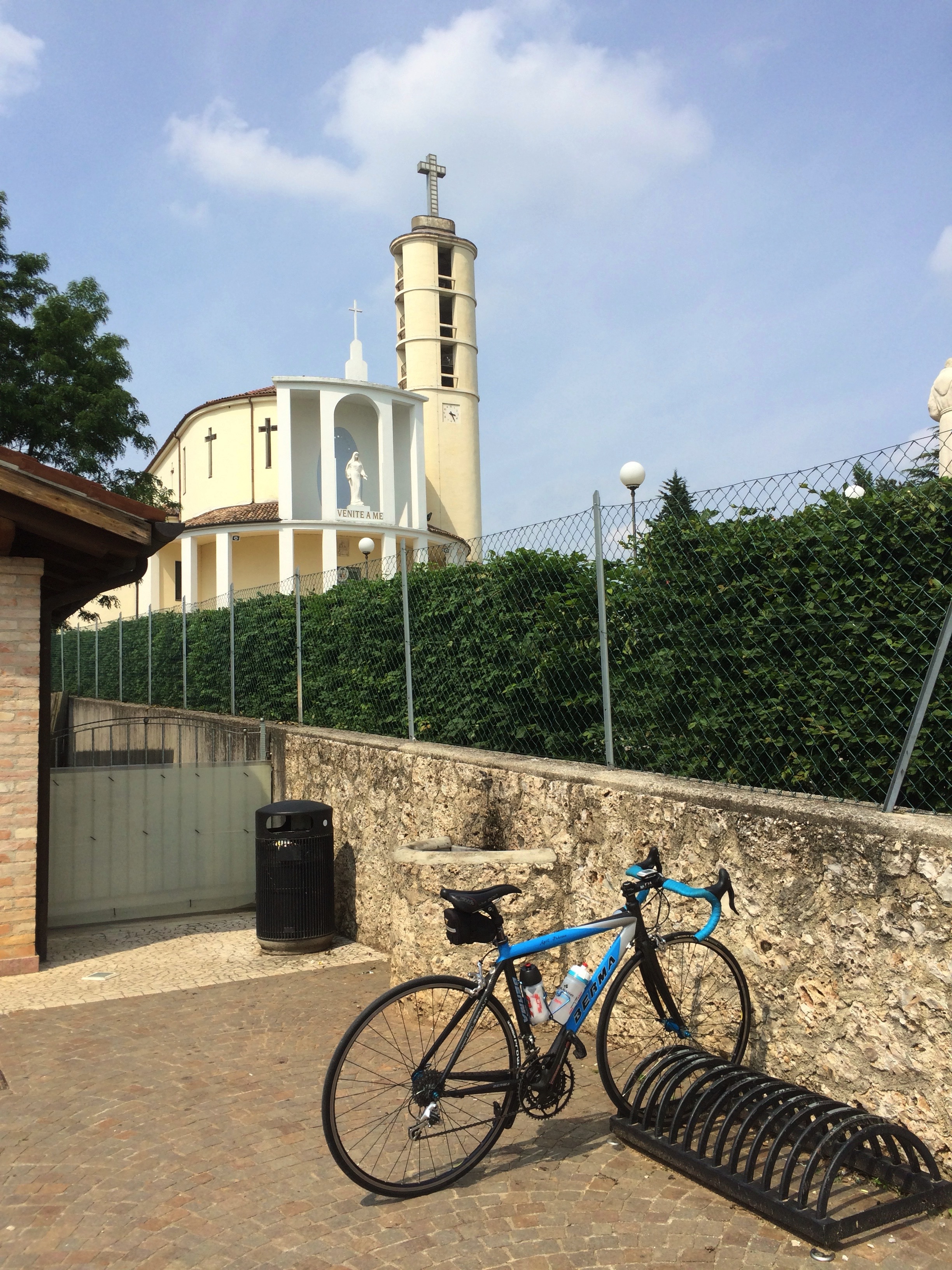
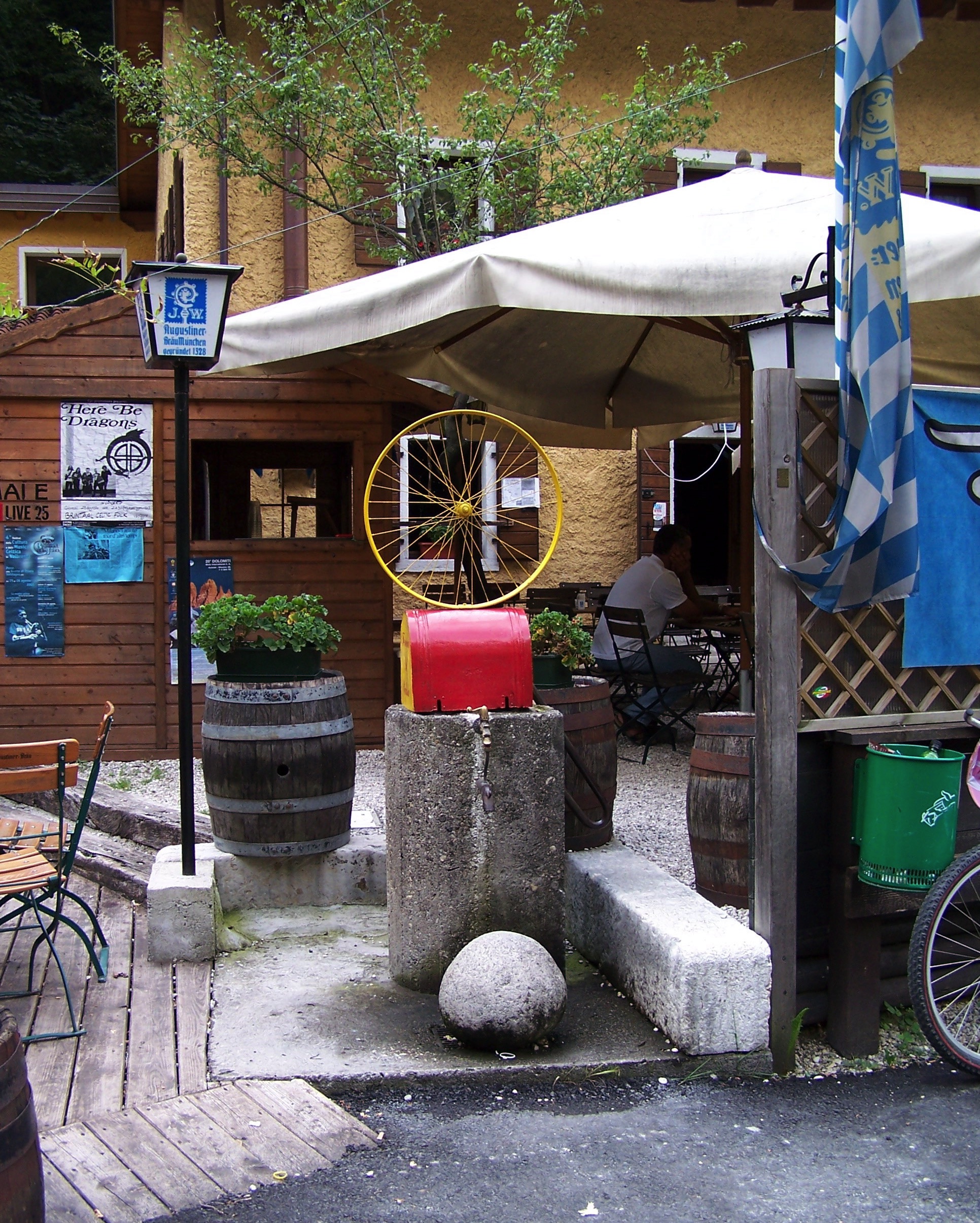
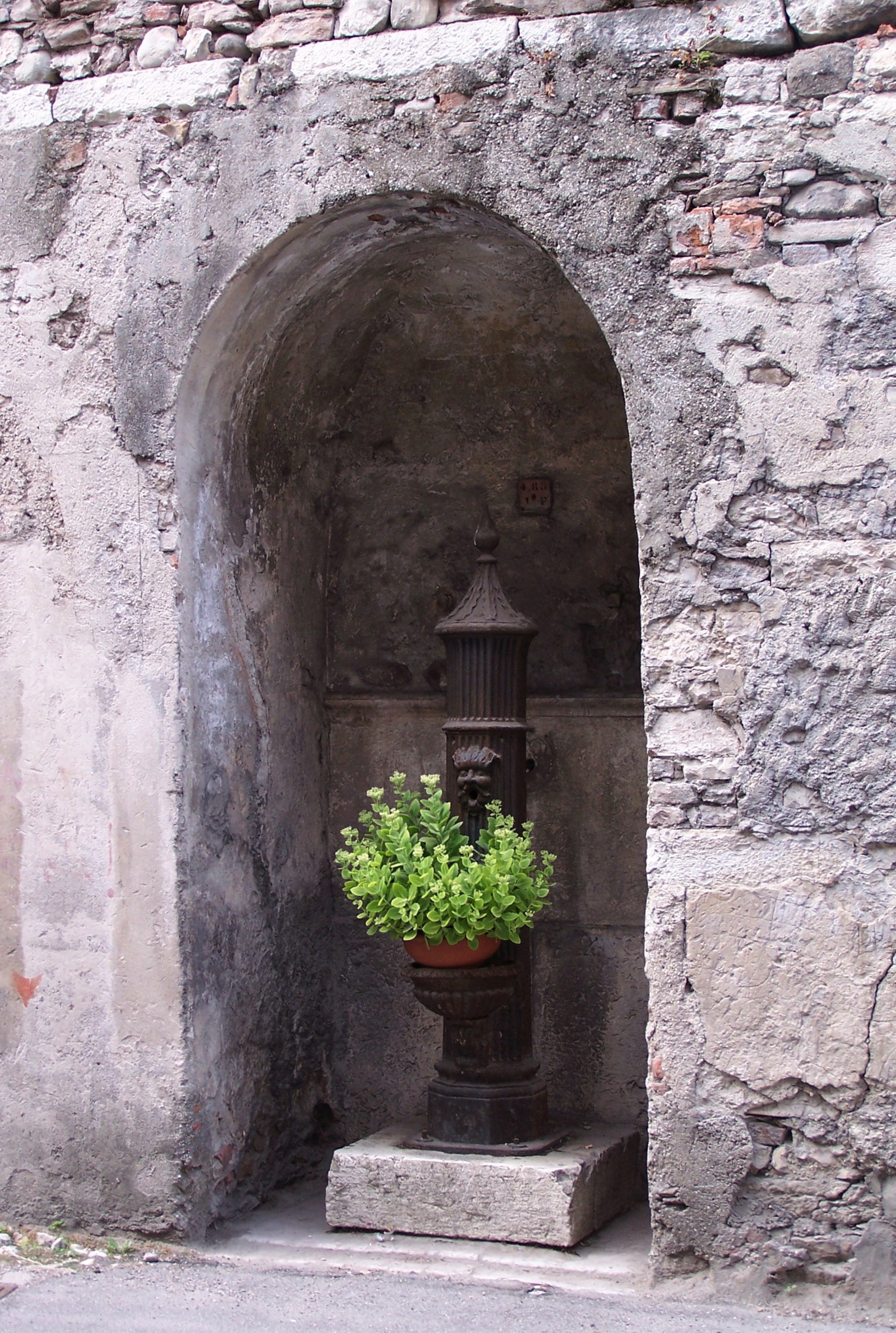
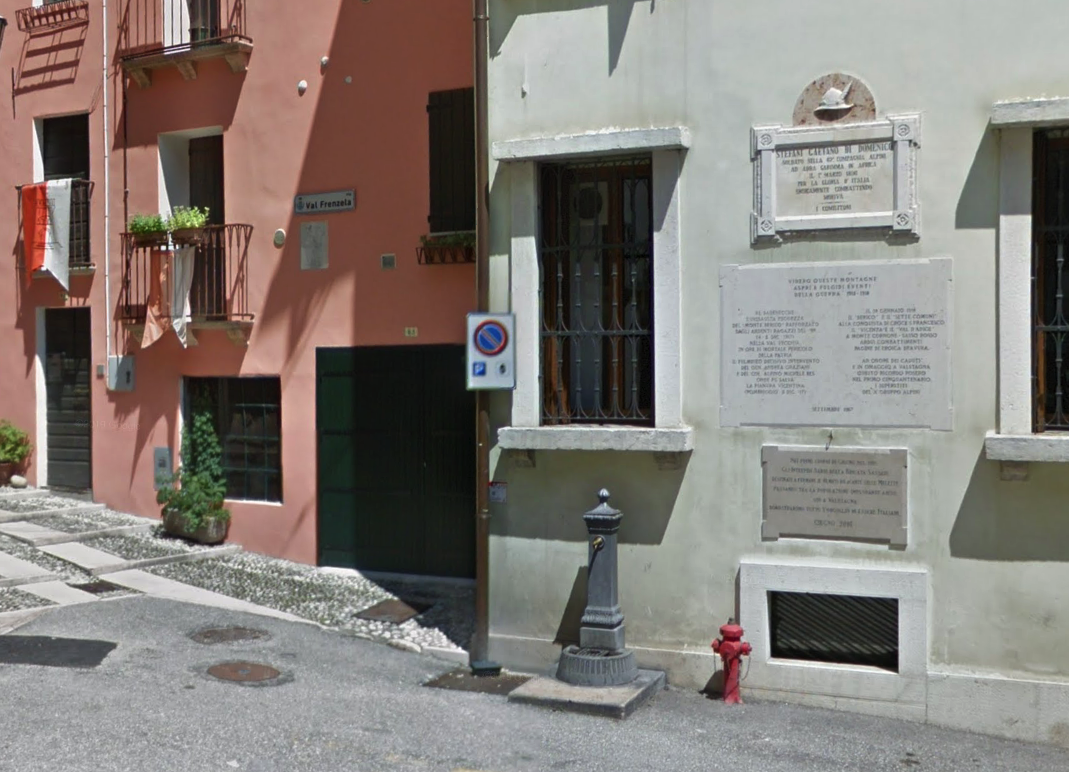
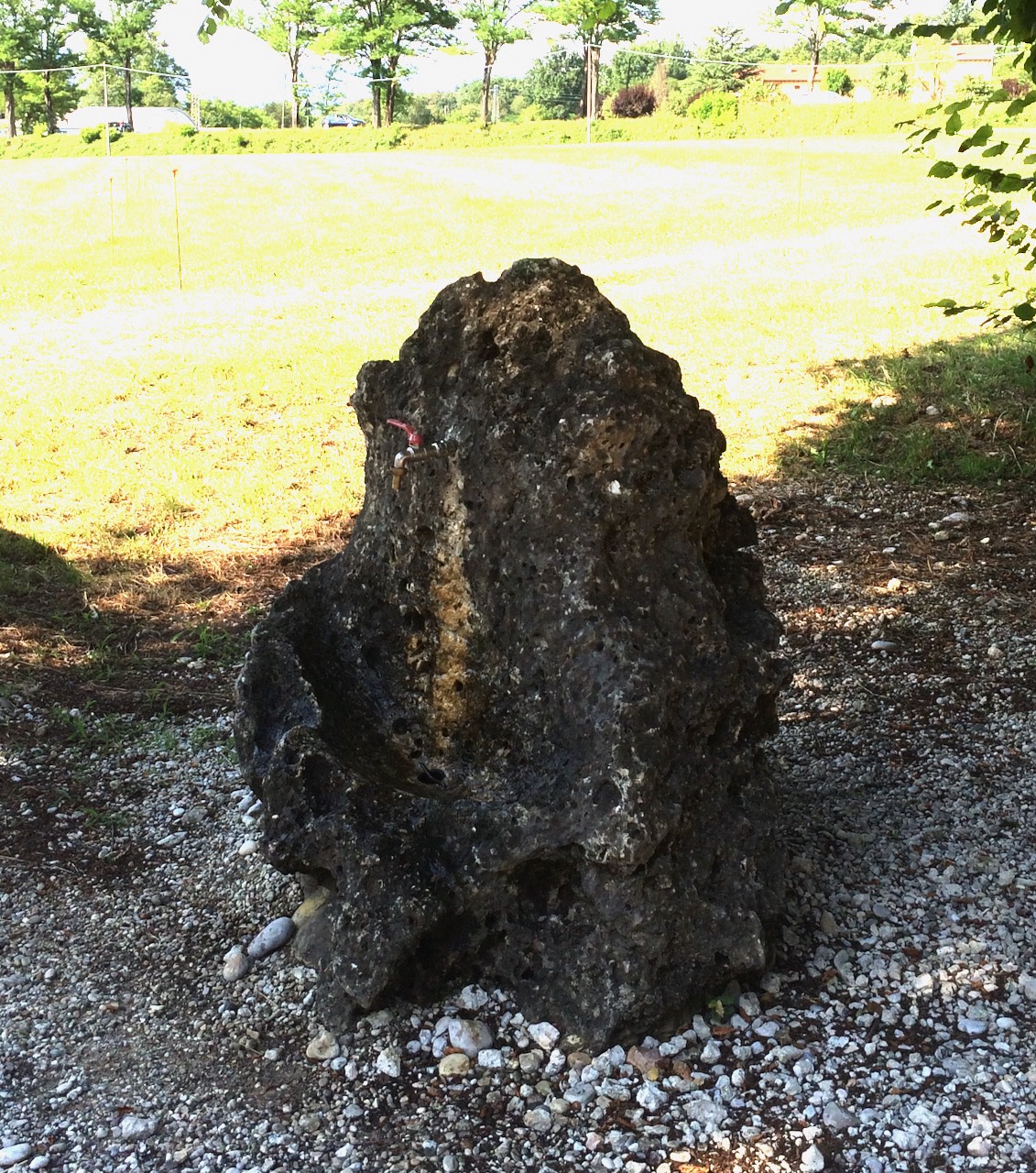
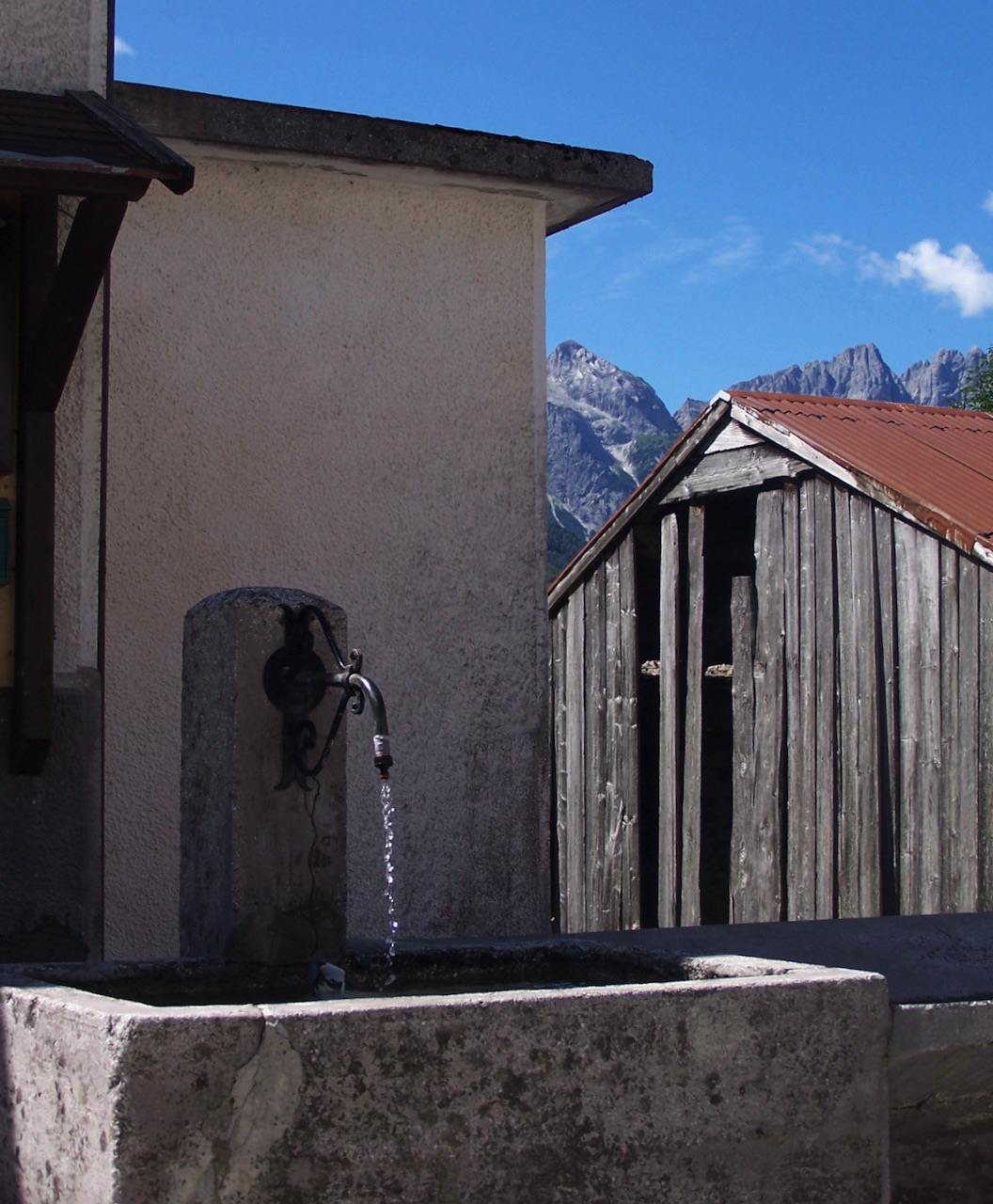
all photos © April Pedersen Santinon.
Fountains
The artistically decorated Bottega del Pane in Bassano del Grappa serves a variety of enticing baked goods.
In response to scofflaw cyclists who disobey the traffic lights which regulate traffic on a one-lane main street, the town of Asolo posted the warning at left, which reads:
Cyclist friend!!!
If the hill of Asolo you want to climb
behave yourself when the center of town
you must traverse...
the traffic laws you must respect
otherwise on foot you will have to go.
Thank you
The Local Police.
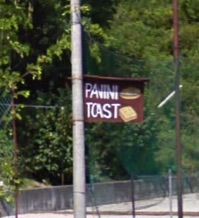
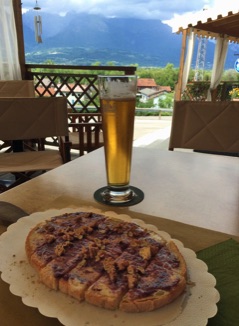
One welcome aspect of riding in Italy is that most towns and villages have public drinking fountains where you can fill up (and cool off), so there's usually no need to carry two large bidons, unless you're doing a long climb on a very hot day. Not all fountains are in plain view; if you don't see one, just ask, "fontana?" (fone TAH nah) or acqua? and point to your water bottle. You may even find fountains along country roads; it's safe to drink from them unless there's a sign that says ACQUA NON POTABILE. Never splash water from a basin on your face, as it will most likely be polluted by pigeons and you can wind up with an eye infection or worse. Bars are required to provide free tap water to anyone who asks.
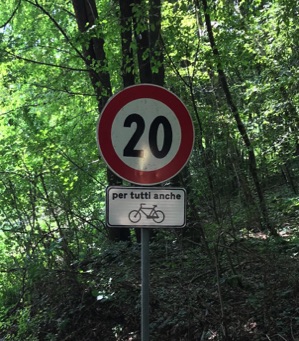
The speed limit sign on this small mountain road has an extra caution...
for everyone, also 🚲
Pastin is another mountain favorite not shown here. It's not a kind of pasta, but a sausage patty, and can also be served on a roll.
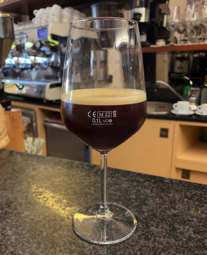
"When the spirits are low, when the day appears dark, when work becomes monotonous, when hope hardly seems worth having, just mount a bicycle and go out for a spin down the road, without thought on anything but the ride you are taking."
Arthur Conan Doyle
